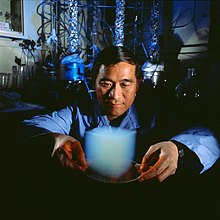Peter Tsou
This article contains content that is written like an advertisement. (May 2016) |
Peter Tsou | |
|---|---|
 Peter Tsou with a sample of aerogel | |
| Citizenship | USA |
| Alma mater | University of California, Berkeley (BS, MS) University of California, Los Angeles (PhD) |
| Known for | Stardust mission |
| Awards | NASA Group Achievement Award NASA Exceptional Achievement Medal |
| Scientific career | |
| Institutions | Jet Propulsion Laboratory |
Peter Tsou is a principal science staff member at the Jet Propulsion Laboratory (JPL) of the California Institute of Technology, where he has worked for the past 34 years.[1] Dr. Tsou's research was focused on using aerogel for space exploration.[2]
Dr. Tsou was a Principal Investigator (PI) for a number of Space Shuttle and Mir missions, and was responsible for inventing the technique of intact capture of hypervelocity particles. In addition, his work revolutionized the use of silica aerogel for space missions. He is most famous for his work involving the capture and return of comet particles via NASA's Stardust mission, to which Dr. Tsou served as deputy PI.[3]
Education[]
Dr. Tsou earned B.S. (1965) and M.S. (1966) in Electrical Engineering at the University of California, Berkeley. He received his PhD in Large Scale Engineering Systems from the University of California, Los Angeles, in 1972.[3]
Career[]
Since 1974, Dr. Tsou has worked at NASA's Jet Propulsion Laboratory, located in Pasadena, CA. He has been involved in multiple projects, most recently as Deputy Principal Investigator (PI) of STARDUST (1994–present). Prior to this, Dr. Tsou served as PI for the MIR Sample Return Experiment (1994–1997), PI for Spacehab II Sample Return Experiment and STARDUST proposal manager (1992–1994), PI for Get Away Special Sample Return Experiment (1989–Present), instrument definition manager (1984–1990), spacecraft system engineer (1982–1990), Task Manager for the Low Cost Solar Array program (1975–1980), and a system engineer (1974–1975).[3]
Prior to his work at JPL, Dr. Tsou worked at University of California, Los Angeles, as a project manager on the Climate Impact Assessment Program of the Supersonic Transport (1970–1974), and at TRW as a technical staff member (1966–1968).
Research[]
His research interests for the past two decades have concentrated on achieving a sample return of cometary coma material. He invented the technique of intact capture of hypervelocity particles for just such a mission as Stardust, the 13th proposal for a comet flyby sample return mission. Working with scientists at Lawrence Livermore National Laboratory, he made the aerogel material lighter and more suitable for catching the comet particles.[4] He has also introduced the use of aerogel as one of the capture media and flight qualified variable density aerogel for space flight.
Dr. Tsou has donated several samples of aerogel for several museums: JPL's museum, located on their main campus in Pasadena, CA;[5] the Kirkpatrick Science & Air Space Museum, also known as the Omniplex Science Center, for the first public display of the traveling "Stardust Cafe" exhibit;[6] Santa Monica College for display in their science complex.[2]
He was the principal investigator for a series of Shuttle Sample Return Experiments and Mir Sample Return Experiment with silica aerogel he made at JPL. He continues to develop improved techniques to identify, remove and study particles captured in aerogel.
Dr. Tsou was responsible for inventing an integrated aerogel thermal-structural design for the Mars Pathfinder Sojourner rover, another breakthrough for space thermal insulation.[7]
His other research interests include exobiological implications of extraterrestrial bodies and methods to sample extraterrestrial materials.
Publications[]
Dr. Tsou has authored and co-authored more than 60 technical papers. Some selected publications:
- Tsou, P., F. Giovane, J-C. Liou, R. Corsaro. "Large Area Dust Collection – on the International Space Station", 2007.
- Tsou, P., D. E. Brownlee, R. Glesias, C. P. Grigoropoulos, M. Weschler, "Cutting Silica Aerogel for Particle Extraction", 36th LPSC, 2307, 2005.
- Tsou, P., "Cosmic Dust Intact Capture Experiment", STAIF-99, 1999.
- Tsou, P., "Hypervelocity Capture of Meteoroids in Aerogel", ASPCS Vol 104, 237–242, 1996.
- Tsou, P., Albee A. L., "Comet Flyby Sample Return", AIAA-85-0465, 1985.
Awards[3][]
- 2000 NASA Patent: Large Field of View 3-D Hologram Display System
- 2000 NASA Group Achievement Award - STARDUST Project Team
- 1997 NASA Exceptional Achievement Medal
- 1996 JPL Inaugural Award for Excellence - Exceptional Technical Excellence
- 1985 NASA Group Achievement Award - Low Cost Solar Array Project
References[]
- ^ "Bios - Dr. Peter Tsou". NASA. Retrieved 2006-05-11.
- ^ a b Intriguing Aerogel Display at SMC
- ^ a b c d "Asteroids, Comets & Satellites: People - Peter Tsou". JPL Science. Archived from the original on 2009-04-13.
- ^ Irion, Robert (October 2003). "To Catch a Comet". Discover. Archived from the original on 2003-11-19. Retrieved 2006-05-11.
- ^ NASA - Jet Propulsion Laboratory: The Universe and Beyond
- ^ NASA Stardust Launch Press Kit
- ^ Tsou, P., “STARDUST: a Comet Coma Flyby Sample Return”, IEEE, 2009.
- Living people
- American scientists
- NASA people
- UC Berkeley College of Engineering alumni
- University of California, Los Angeles alumni
- University of California, Los Angeles staff